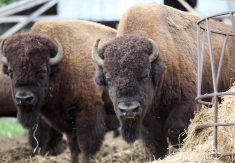CIDA CUTS
In a letter dated Nov. 16, minister of international co-operation Julian Fantino talked about Canada’s assistance on the combat against tuberculosis but obviously avoided talking about the major cuts in CIDA’s (Canadian International Development Agency) budget and their impacts on tuberculosis-related deaths.
The bottom line is that minister Fantino’s government is cutting $319 million over the next three years in CIDA’s budget, which in-cludes reducing multilateral spending on tuberculosis control by $10 million per year.
As it costs about $20 per patient to cure this preventable disease, these savings represent quite a lot in terms of human lives.
Read Also

High prices see cow-calf producers rushing to incorporate
Farm accountants are reporting a steady stream of cow-calf producers rushing to get their operations incorporated ahead of selling their calves this fall.
Bruno Marquis,
Gatineau, Que.
HAY, CANADA
I have read the article in the paper about HayEast. As a former hay producer, I know we went through this situation in Western Canada.
When the hay was brought in from the east, the freight on it was about $170 per ton. Hay was given to people on a draw system. I know some of the hay went to people who did not need it, but that always happens.
As I said, I am a former hay producer. I had a hard time selling my hay for $120 per ton that year and it was well advertised.
So I think it is a waste of fossil fuel and taxpayers’ money to do it again, especially when the freight is so high. As I understand it, freight is estimated at $7,000 for 40 bales. That’s just ridiculous.
When I was growing hay I had a hard time selling it for even $40 to $60 per ton. I’ve known cattlemen who try to keep a two-year supply of feed on their farms. So when hay is plentiful, why not keep some for a bad growing year?
HayWest and HayEast are wonderful ideas, but the economics destroy the benefits of people’s willingness to give.
There really is no free hay.
Dan Kratchmer,
Outlook, Sask.
BILL NOT RUSHED
I would like to correct the inaccuracies contained in a recent Western Producer article (Nov. 8) about our government’s Safe Food for Canadians Act (S-11).
Let me start by first assuring readers that when it comes to food safety, the health of Canadians is our government’s top priority. Bill S-11 is an important piece of legislation that modernizes Canada’s already world-class food safety system.
To imply that S-11 has been rushed through the parliamentary process is wrong, as it does not match the facts. This legislation has been debated numerous times in both the Senate and the House of Commons.
S-11 has been studied in both the Senate and House of Commons agriculture committees for over 20 hours, during which 46 witnesses appeared, including the minister of agriculture on two occasions.
Both the Senate and House agriculture committees have done their due diligence in their study of S-11.
Going forward, we will work with stakeholders to ensure that the regulations support them as they work to produce safe food for Canadians.
Pierre Lemieux,
MP, Parliamentary secretary
Ottawa, Ont.
SPILL THEORY
Re: The article Petroleum spill prompts farmer to seek tougher government regulations (WP, Nov. 1). The farmer is accusing the oil company of dumping the crude and salt water.
My guess is the trucking company probably dumped the water so that they didn’t have to wait in a lineup to unload, charge the oil company the rate per cube for disposal and continue on to the next job.
Terry Sherman,
MAKE MINE RAW
While I am grateful for all the good that a professional like Clare Rowson has done for the health system, I believe that she is misguided on her stance on raw milk.
In the Q&A in her column Milk, raw or pasteurized? (WP, Sept. 27) she used statistics from the Centre for Disease Control. She informed us that between 1998 and 2006 there were two deaths caused by the consumption of unpasteurized milk and milk products.
Well, I also have some statistics from the CDC. On average, between 2000 and 2004, there have been 392,683 deaths a year in the U.S.A. contributed to the use of tobacco products.
I am no mathematician, but I calculate the consumption of raw milk to have contributed to 0.25 deaths a year in the 28 states that it is legal. Compared to the deaths caused by tobacco, I would say raw milk should not even be on the radar.
I will get to the point. If I am informed, should I not have the choice to purchase and consume raw milk? I can buy cigarettes and whiskey, but I cannot buy a glass of milk fresh from the cow. Not sure about you, but I see something very wrong with that picture.
Raw milk products are currently sold under the pretense that they will not be used for human consumption.
Can you imagine having to hide the fact that you are drinking milk fresh from a cow, the stuff that makes tough little calves grow into T-bones?
As a proud Canadian, I believe that if I want to ingest raw milk, I should not have to seek it out as if I am buying an illegal narcotic.
To end my rant, I would like to say thank you to all the health practitioners and ask that they keep an open mind toward alternatives to the conventional food system.
Mike Andriuk,
Big River, Sask.
DOMESTICATED HORSES
Wayne Krejci and Shelby Mac-Kenzie in their letter to the Editor (WP Nov. 15) try to convince everyone that the so-called wild horses in Alberta are genuinely wild and not descended from domesticated horses; in other words, not feral.
Then they go on to say that these wild horses date back before the European settlers arrived, dating back to a “Spanish horse foundation.”
History shows that there were no horses of any kind in America until the Spanish brought domesticated horses to the continent starting in the 16th century.
That would make the “Spanish horse foundation” quote somewhat true. As to “European,” as far back as I can remember, Spain has been a part of Europe, therefore, our wild horses are descendants of the “Spanish horse foundation,” which were domesticated horses brought to America by the Spanish, who also happened to be Europeans.
Don Budesheim,
Grande Prairie, Alta.














